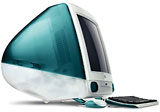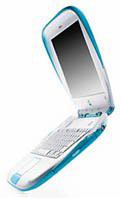Harken back to mid-2004. Apple, announcing features of its upcoming
OS X 10.4 "Tiger", festooned its developers' conference auditorium
with banners reading "Redmond, start your photocopiers." The
not-so-subtle message: Apple innovates, Microsoft, mired in delays
getting what would be Windows Vista to market, copies.
 Like most
modern myths, reality is more nuanced. Take Apple's August 15 ship date
to celebrate the iMac's 10th anniversary. The original iMac was an egg-shaped
blue-and-white one-piece computer that looked unlike any previous
desktop computer. Up until then, computers - both Macs and PCs - came
in beige cases with separate beige monitors.
Like most
modern myths, reality is more nuanced. Take Apple's August 15 ship date
to celebrate the iMac's 10th anniversary. The original iMac was an egg-shaped
blue-and-white one-piece computer that looked unlike any previous
desktop computer. Up until then, computers - both Macs and PCs - came
in beige cases with separate beige monitors.
And unlike other desktops - both Macs and PCs - the iMac lacked a
floppy disk drive and used USB to connect to keyboard, mouse, and
printer. Initial reaction from the media and many members of the public
was puzzlement. No floppy drive? And were there any printers, scanners,
or other devices that could connect to those USB ports?
Apple innovation, right?
In fact, USB was developed by Intel. It, along with Microsoft, had
been pushing PC makers to use it in place of parallel and serial ports,
ISA slots, and keyboard and mouse connectors dating back to IBM's 1983
AT.
At the April 1997 Windows Hardware Engineering Conference, Microsoft
and Intel proposed PC98 specifications. The two companies felt dropping
legacy connectors and replacing them with USB was required for better
PC performance and reliability. But PC hardware manufacturers weren't
listening: 1998-model PCs remained beige boxes with old-style
connectors.
Ironically, Apple was listening. Apple's hardware used its own set
of old-style connectors - DIN-8 serial, NuBus, SCSI, and ADB (Apple
Desktop Bus). And with Apple's then-shrinking market share,
manufacturers of printers and other computer peripherals were
increasingly uninterested in including Mac compatibility.
So while PC hardware manufacturers were unwilling to be the first to
"think different", Apple made that slogan its corporate motto with its
1998 iMac.
The iMac spelled the end for the beige-box PC. Your current PC is
more likely to be black or silver or white and makes at least some
attempt at attractiveness - a reflection of the original iMac's
contention that attention to style is worthwhile, even in products
aimed at business users.
The iMac kick-started demand for USB-connected products. With USB
compatibility also included in Microsoft's just-released Windows 98,
even reluctant PC manufacturers were building USB connectors into their
products by 1999, eventually using it in place of old-style printer,
keyboard, and mouse connectors. Today, most computer peripherals
connect via USB, and few computers bother with old-style ports.
And when was the last time you used a floppy diskette? First PC
notebooks - and more recently most PC desktops - stopped bothering to
include a floppy disk drive.
The successful 1998 iMac release also had other spinoffs, including
far too many products with names starting with a lower-case "i" - not
all of them from Apple. That "i" originally stood for Internet, to
underscore Apple's claims that the iMac was designed for easy
connection to the Net.
 It
followed that up with iPods and iPhones and more, devices that were not
necessarily Internet-connected. Similarly, the original iMac's
blue-and-white plastic colour scheme was copied onto late '90s plastic gadgets, from ballpoint
pens to alarm clocks. And as the first of a series of successful Apple
products under the leadership of returned CEO Steve Jobs and
industrial designer Jonathan Ive, it saved Apple.
It
followed that up with iPods and iPhones and more, devices that were not
necessarily Internet-connected. Similarly, the original iMac's
blue-and-white plastic colour scheme was copied onto late '90s plastic gadgets, from ballpoint
pens to alarm clocks. And as the first of a series of successful Apple
products under the leadership of returned CEO Steve Jobs and
industrial designer Jonathan Ive, it saved Apple.
The following year, Apple released its iBook notebook, again in a
curvy colourful case with USB built-in. That model popularized WiFi,
again a technology that had been around for a while but was not widely
used.
As with the original iMac, Apple's lead was not in creating
something new, but in successfully prodding both the public and a
reluctant PC industry to adopt useful technologies that were out there
but being ignored. 
First published in Business in Vancouver, September 30-October
6, 2008; issue 988

 Like most
modern myths, reality is more nuanced. Take Apple's August 15 ship date
to celebrate the iMac's 10th anniversary. The
Like most
modern myths, reality is more nuanced. Take Apple's August 15 ship date
to celebrate the iMac's 10th anniversary. The  It
followed that up with iPods and iPhones and more, devices that were not
necessarily Internet-connected. Similarly, the original iMac's
blue-and-white plastic colour scheme was copied onto
It
followed that up with iPods and iPhones and more, devices that were not
necessarily Internet-connected. Similarly, the original iMac's
blue-and-white plastic colour scheme was copied onto 
